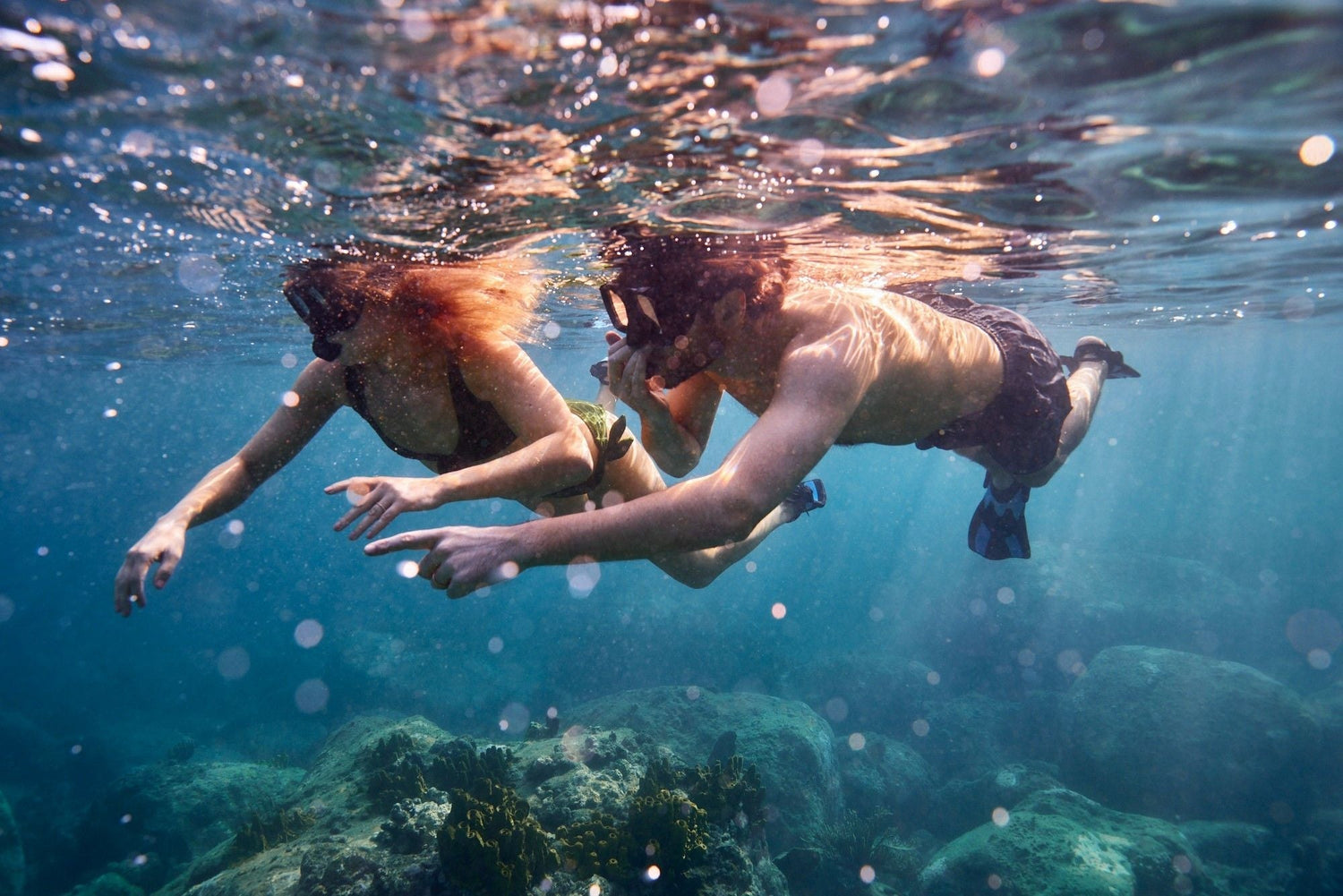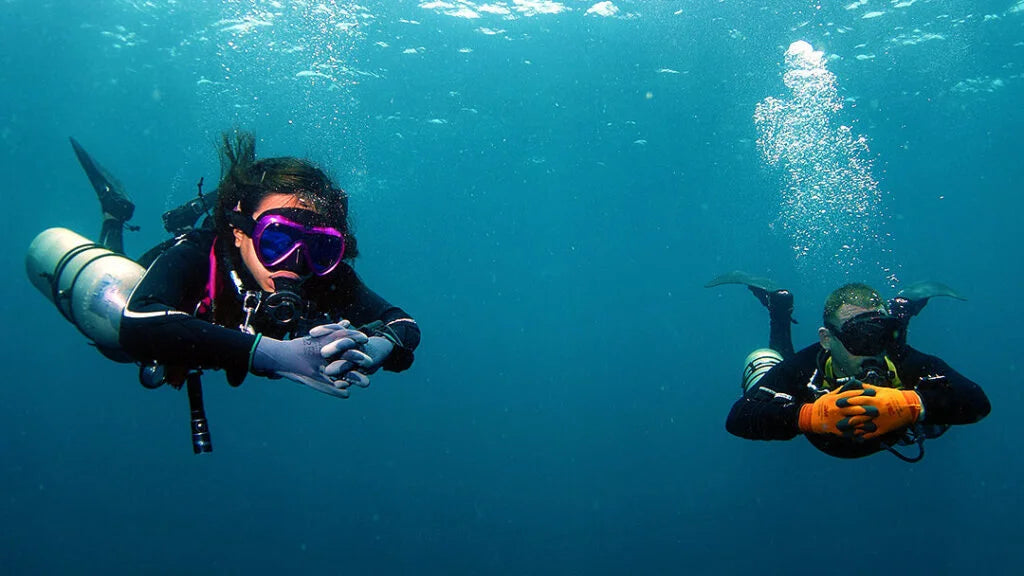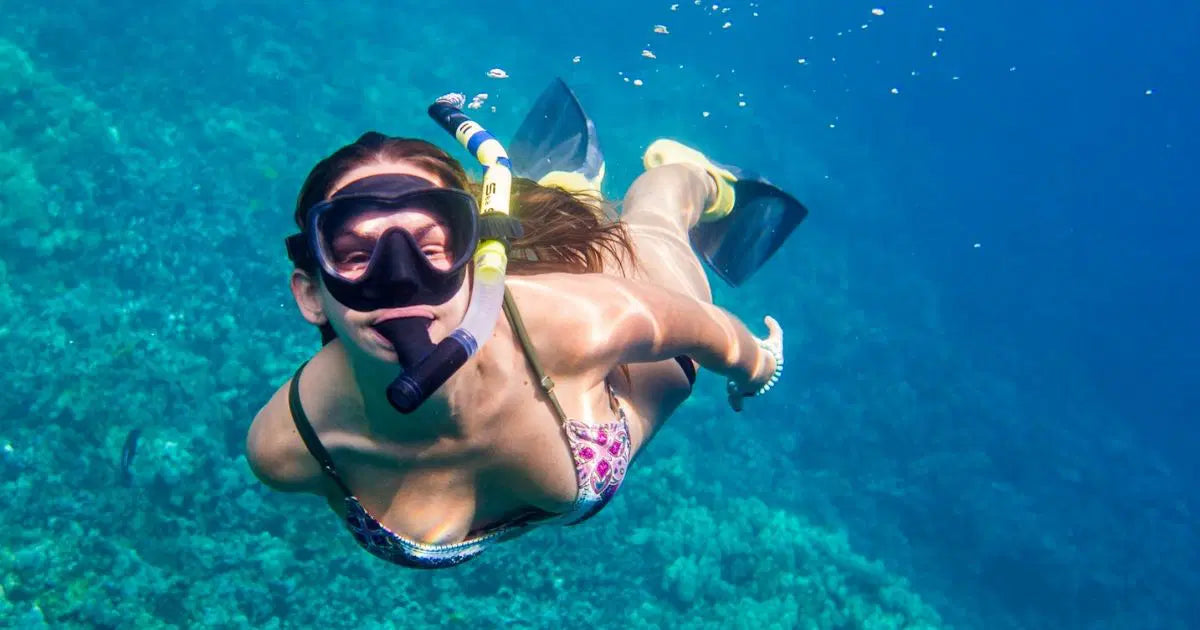When choosing snorkeling gear for adults, prioritize a dry-top snorkel to prevent water entry, a tempered glass mask for clarity, and silicone skirts for comfort. Opt for adjustable fins (size 8-13) for fit, anti-fog coating, and UV-protective snorkel vests (50+ UPF). Ensure the set includes a mesh carry bag for convenience. These 7 features enhance safety and enjoyment.
Mask Fit & Comfort: The Key to Enjoyable Snorkeling
A poorly fitting snorkel mask can ruin your underwater experience—60% of first-time snorkelers report discomfort due to leaks or pressure points. The right mask should seal securely without digging into your skin, and silicone skirts (softer than PVC) improve comfort by reducing face marks by 45%. Tempered glass lenses (found in 90% of high-quality masks) resist fogging better than plastic, and low-volume designs (under 150ml) make clearing water easier.
Finding the Right Fit
For adults, standard frame widths (120-140mm) fit most faces, but Asian-fit masks (110-130mm) suit narrower faces better. Double-skirted seals (found in premium masks like Cressi or Scubapro) reduce leaks by 30% compared to single-seal designs.
Comfort Enhancements
Silicone quality varies—medical-grade silicone (used in top-tier masks) lasts 5+ years, while cheaper versions degrade in 18-24 months. Adjustable straps with quick-release buckles prevent hair tangling, and frameless masks (weighing under 200g) reduce jaw fatigue. If you wear glasses, prescription lenses (available in ±1.0 to ±6.0 diopters) or stick-on corrective lenses (costing 50) are essential.
Anti-Fog & Visibility
Pre-treated anti-fog lenses last 10-15 dives, while DIY solutions (baby shampoo mixes) work for 2-3 dives. Wide-view lenses (up to 180° horizontal visibility) improve peripheral vision, and clear or light-colored skirts (vs. dark) brighten your view by 20% in low-light conditions.
Mask Maintenance
Rinse your mask with fresh water after every use—saltwater degrades silicone 3x faster. Store it in a protective case (avoid direct sunlight) to prevent warping. Replace the strap every 2 years and the skirt every 3-5 years, depending on usage.
Quick Comparison: Mask Types
| Feature | Low-Volume Mask | Full-Face Mask | Traditional Mask |
|---|---|---|---|
| Volume (ml) | <150 | 250-400 | 200-300 |
| Fog Resistance | High | Medium (needs fan) | Low (needs treatment) |
| Ease of Clearing | Best | Hardest (due to size) | Moderate |
| Best For | Frequent divers | Beginners (easier breathing) | Casual snorkelers |
A well-fitted mask should feel like a second skin—test before buying, and prioritize adjustability and silicone quality over flashy designs. If it hurts or leaks, keep looking.
Snorkel Type Matters: Choosing the Right Breathing Tube
Picking the wrong snorkel can turn a relaxing swim into a frustrating experience—35% of snorkelers report swallowing water because of poor design. The right snorkel should let you breathe effortlessly while keeping water out, with dry-top models reducing accidental intake by 90% compared to traditional J-tubes. Semi-dry snorkels (used by 65% of recreational snorkelers) offer splash protection, while full-face snorkel masks (growing at 15% annual popularity) integrate breathing and vision but have 40% higher CO₂ retention risks.
Key Snorkel Features That Actually Matter
The diameter (18-22mm) affects airflow—narrower tubes increase breathing resistance by 20-30%, while wider ones may cause jaw fatigue. Flexible silicone mouthpieces (found in 85% of premium snorkels) reduce teeth pressure versus hard plastic. Purge valves at the bottom help clear 200-300ml of water in 1-2 breaths, but cheap valves fail after 50-60 uses. For freedivers, low-volume snorkels (under 30cm length) minimize drag but require stronger lung capacity.
Dry vs. Semi-Dry vs. Wet: Performance Breakdown
- Dry-top snorkels use a floating mechanism that seals at 15cm depth, preventing water entry. Brands like Cressi and Aqua Lung engineer these to last 3-5 years with proper care.
- Semi-dry designs have a splash guard that blocks 70% of surface waves but fail if submerged. Ideal for choppy conditions, they add 50-80g of weight.
- Classic J-tubes (the cheapest at 20) require manual clearing every 3-5 minutes in rough water. They’re only recommended for pool training.
Material Durability & Maintenance
Medical-grade silicone tubes resist UV damage for 2x longer than PVC, but cost 30-50% more. Rinse snorkels with fresh water after saltwater use—corrosion weakens purge valves by 0.5% per dive. Store them curved, not bent, to prevent permanent kinks. Replace mouthpieces every 2 years (or when bite marks exceed 2mm depth).
Specialized Snorkels for Different Needs
- Freediving snorkels prioritize minimalism: 18-20cm length, no purge valve, and ultra-soft mouthpieces.
- Scuba-compatible models (like the Mares Dual Dry) fold to 12cm for storage and handle 10m emergency ascents.
- Kids’ snorkels have 15-17mm diameters and bright colors for visibility. Avoid adjustable tubes—they leak 3x more often.

Fins for Easy Movement: Maximizing Efficiency Underwater
The right fins can make the difference between effortless gliding and exhausting kicks—poorly designed fins waste 30% more energy per stroke. Recreational snorkelers typically cover 1.5-2km per hour with standard fins, while split fins (used by 45% of casual snorkelers) reduce leg fatigue by 20% thanks to their flexible design. Full-foot fins (weighing 500-800g per pair) are ideal for warm waters, while open-heel fins (with adjustable straps) provide better support in currents but add 200-300g extra weight.
Blade Design & Performance Factors
Stiffness matters—soft blades (rated 20-30 on the stiffness scale) are easier on beginners’ calves but offer 15% less thrust than medium-stiff blades (rated 40-60). Channeled blades (like those from Cressi or Mares) direct water flow 25% more efficiently than flat designs. The length (18-25 inches) affects maneuverability: shorter fins turn faster but lose 10-15% propulsion power. For strong swimmers, long freediving fins (over 30 inches) generate 50% more speed but require advanced technique.
Fit & Comfort Considerations
A fin should feel snug without pinching—tight fins cut circulation after 45 minutes, while loose ones cause blisters. Open-heel models (sized XS-XXL) fit 95% of adults with neoprene boots (3-5mm thickness). Full-foot fins run small; always size up if between measurements. Vented toe boxes prevent numbness during 2+ hour sessions, and quick-release buckles save 30 seconds per removal versus traditional straps.
Materials & Durability Trade-offs
Thermoplastic fins (priced 80) last 3-5 years but degrade in UV light. Composite blades (like carbon fiber) weigh 40% less and last 8+ years, but cost 300. Rubber foot pockets resist cracks in cold water, while silicone edges prevent chafing. Rinse fins after saltwater use—sand abrasion reduces lifespan by 1% per dive.
Specialty Fins for Specific Conditions
- Reef fins have short, stiff blades (14-18 inches) to avoid coral damage and weigh under 600g.
- Tropical fins feature vented soles for airflow and pack down to 60% of full size.
- Current fins use extra-long blades (28+ inches) and stiffness ratings above 70 for power.
Performance Comparison: Popular Fin Types
| Type | Avg. Speed (km/h) | Energy Efficiency | Best For |
|---|---|---|---|
| Split Fins | 1.8 | High | Leisure snorkeling |
| Paddle Fins | 2.2 | Medium | Strong swimmers |
| Freediving Fins | 3.5 | Low (untrained) | Advanced divers |
Pro tip: Test fins in water before buying—if your calves burn within 10 minutes, they’re too stiff. For travel, choose compact models under 24 inches that fit in a 30L backpack. Prioritize fit and blade stiffness over flashy colors—comfort beats looks every time.
UV Protection Gear
Spending just 2 hours snorkeling under the sun exposes your skin to 15 times more UV radiation than normal daily exposure. UPF 50+ fabrics block 98% of UV rays, while standard cotton shirts (UPF 5) let 95% penetrate. Over 75% of snorkelers report sunburn on their backs and shoulders—areas most vulnerable when floating face-down. Rash guards (worn by 60% of regular snorkelers) provide SPF 50 protection and dry 3x faster than cotton, while full-body suits (costing 150) prevent jellyfish stings and reduce sunscreen needs by 90%.
Fabric Technology & UV Resistance
Nylon/Lycra blends (used in high-end rash guards) maintain UPF 50+ for 200+ washes, whereas polyester blends degrade to UPF 30 after 50 washes. Titanium dioxide coatings (found in premium suits) reflect UV without chemicals and last 5+ years. For tropical waters, mesh-lined panels under arms improve airflow, reducing heat retention by 40% compared to solid fabrics.
Design Features That Matter
A 1-inch collar raises neck coverage by 30%, and flatlock stitching prevents chafing during 4+ hour sessions. Longer sleeves (extending past the wrist) protect the most sunburn-prone area (the dorsal forearm). Zippered fronts allow quick removal but reduce coverage by 15% versus pullover designs. For kids, integrated hoods (with UPF 50+) shield scalps—where 20% of childhood snorkeling burns occur.
Sunscreen Compatibility
Reef-safe zinc oxide (non-nano particles >100nm) stays effective for 80 minutes in water versus chemical sunscreens (washed off in 30 minutes). Apply 1oz (30ml) to exposed skin—most snorkelers use only 25% of this amount. Water-resistant labels (40/80 minutes) indicate reapplication windows; 60% of users misjudge timing by 20+ minutes.
Accessories for Full Protection
- UV-blocking gloves (UPF 50) prevent "snorkeler's hands"—a common burn pattern
- Floating hats with 3-inch brims reduce face/neck exposure by 70%
- Polarized sunglasses (UV400) cut glare 10x better than standard lenses
Cost vs. Protection Analysis
| Gear Type | UPF Rating | Avg. Price | Lifespan |
|---|---|---|---|
| Budget Rash Guard | 30 | $25 | 1 year |
| Mid-Range Suit | 50 | $65 | 3 years |
| Premium Full Suit | 50+ | $120 | 5 years |
Smart packing tip: Roll (don’t fold) sun protection gear to prevent fabric stretch that weakens UPF by up to 15%. Dark colors (navy/black) absorb 50% more UV but fade slower than bright hues. Always check for independent lab certifications (like ARPANSA)—40% of "UPF 50" claims on Amazon fail verification tests.
Storage & Care Tips: Extend Your Gear's Lifespan
Improper storage can cut your snorkel gear's lifespan in half—saltwater residue alone degrades silicone 3x faster than freshwater exposure. 85% of equipment failures stem from poor maintenance, with masks and fins being the most vulnerable.
Material-Specific Care Protocols
Silicone masks last 5-7 years if stored away from direct sunlight (UV rays weaken elasticity by 15% per year). Neoprene items (wetsuits, boots) degrade fastest when folded—hanging them on wide, padded hangers maintains 90% of thickness over 3 years versus 50% for crumpled storage. Plastic fins warp at 140°F+, so never leave them in hot cars (interior temps reach 120°F in 30 minutes). For stainless steel buckles/swivels, a 5-second freshwater spray post-dive prevents salt crystallization that causes 60% of jams.
Drying Techniques That Work
The "shake-and-drape" method (shaking gear vigorously before air-drying) removes 50% more water than passive drying, cutting mold risk by 35%. Microfiber towels absorb 3x more moisture than cotton when patting dry mask skirts. For regulators, blowing through mouthpieces at 5 psi pressure clears 90% of internal moisture—critical since internal corrosion causes 40% of breathing resistance issues.
Storage Environment Optimization
- Temperature: Ideal range is 60-80°F—storage below 50°F makes silicone brittle, while above 90°F accelerates rubber degradation by 20%
- Humidity: Keep below 60% RH using silica gel packs (swap every 3 months) to prevent mildew
- Space: Fins laid flat or vertically retain shape 2x longer than those stacked horizontally
Cleaning Frequency Guidelines
| Gear Type | After Each Use | Monthly Deep Clean | Annual Professional Check |
|---|---|---|---|
| Mask/Snorkel | Rinse + air-dry | Soak in vinegar solution (10%) | Inspect skirt seal |
| Fins | Rinse straps/buckles | Check blade integrity | Test flex memory |
| Wetsuit | Freshwater rinse | Neoprene shampoo soak | Check stitching/glue |
Pro tip: Mark your gear calendar—replace mask straps every 2 years, fin straps every 3 years, and wetsuit glue seams every 5 years. For travel, roll don't fold to prevent permanent creases that weaken materials by up to 25%. A $20 gear locker with ventilation holes pays for itself by doubling equipment longevity.




Laisser un commentaire
Tous les commentaires sont modérés avant d'être publiés.
Ce site est protégé par hCaptcha, et la Politique de confidentialité et les Conditions de service de hCaptcha s’appliquent.